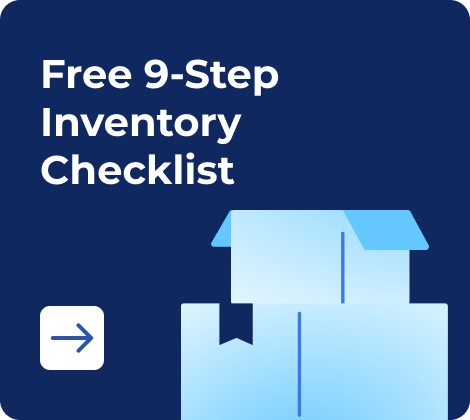Effective inventory management is the backbone of a thriving retail operation, directly impacting profitability and customer satisfaction. It involves the meticulous oversight of stock levels to ensure the right products are available at the right time, minimizing both excess inventory and stockouts. In a retail context, this process extends beyond simple stock control; it integrates demand forecasting, inventory tracking, and supply chain coordination.
By leveraging advanced retail inventory management solutions, retailers can enhance operational efficiency, optimize stock turnover, and ultimately drive sales growth. Understanding these elements is crucial for retailers aiming to streamline their operations and maintain a competitive edge.
What Is Inventory Management for Retailers?
Inventory management is a vital component of retail operations, directly influencing both customer satisfaction and business efficiency. For retailers, this process involves not only tracking stock levels but also implementing strategies that ensure products are available when needed while minimizing excess inventory.
Definition and Importance of Retail Inventory Management
Retail inventory management encompasses the strategies and practices involved in overseeing stock levels and ensuring that inventory aligns with consumer demand. This process is crucial for maintaining the delicate balance between having enough products to meet customer needs while avoiding the costs associated with overstocking.
Effective retail inventory management not only helps in reducing carrying costs and minimizing stockouts but also plays a pivotal role in enhancing sales opportunities and customer satisfaction. By implementing inventory management systems, retailers can gain real-time visibility into stock levels, forecast demand more accurately, and streamline their supply chain operations, ultimately driving profitability and operational efficiency.
Core Principles of Inventory Management
Several core principles form the foundation of effective inventory management. Stock turnover rate, which measures how frequently inventory is sold and replaced, is essential for optimizing stock levels and ensuring that products are fresh and in demand. Safety stock acts as a buffer against unexpected demand fluctuations or supply chain disruptions, preventing stockouts and ensuring product availability. Reorder points are critical for triggering new orders before stock levels fall below a critical threshold, thereby maintaining optimal inventory levels and avoiding lost sales. These principles, when applied correctly, enhance inventory control and support a more responsive and efficient retail operation.
Read‑alikes
15 Key Inventory Management Techniques: How to Choose the Best One
ERP Inventory Management: 12 Benefits for Your Business in Full Guide
10 Common Inventory Management Mistakes: Challenges, Risks and Solutions
Choosing the Right Retail Inventory Management Software
Selecting the appropriate inventory management software is crucial for enhancing retail operations and accuracy. With a range of solutions available, retailers must consider their specific needs to choose the right fit. These systems can significantly streamline processes, reduce errors, and provide valuable insights into inventory performance.
Types of Inventory Management Software
There are several types of inventory management software available, each catering to different business needs and operational models. The two primary categories are standalone inventory management systems and integrated ERP solutions.
- Standalone inventory management software is designed solely to manage stock levels, track product movement, and streamline reordering processes. This type of software is ideal for small businesses or retailers with specific inventory needs that do not require complex integrations. It offers a more focused, user-friendly experience but may require manual data entry for tasks outside of inventory management.
- On the other hand, integrated ERP systems like Kladana ERP offer a comprehensive solution by combining inventory management with other business functions such as sales, accounting, and customer relationship management. These all-in-one systems are best suited for growing retailers who need to manage multiple aspects of their operations under one platform. With ERP solutions, inventory data is automatically synchronized across departments, reducing errors and enhancing operational efficiency.
Understanding the differences between these software types will help you choose the one that aligns with your business’s complexity and growth potential.
Main Factors to Consider While Choosing an Inventory Management Software
To ensure you’re making the right choice, focus on factors like scalability, integration, ease of use, and reporting capabilities. Scalability is essential for growing businesses, as it allows you to add more products, users, and locations without having to switch to a new system. Similarly, robust integration capabilities enable seamless connections with e-commerce platforms, CRM systems, and accounting tools, reducing manual data entry and minimizing errors.
Ease of use is equally important. A user-friendly interface shortens the onboarding process, helping your staff quickly master the system and reducing the likelihood of costly mistakes. Additionally, software with customizable features allows you to tailor it to your specific workflows, ensuring it fits seamlessly into your daily operations.
Don’t overlook the importance of comprehensive reporting features. The ability to generate detailed inventory reports in real time provides valuable insights into sales trends, stock levels, and customer demand. This allows for smarter decision-making and more precise inventory control.
| Factor | Why It Matters |
Scalability |
Supports growth without a system upgrade |
Integration |
Automates data flow across platforms, reducing errors |
Ease of Use |
Simplifies staff training and improves productivity |
Reporting Features |
Offers insights for better decision-making and forecasting |
Implementing Best Practices for Retail Inventory Management
Optimizing inventory management is essential for enhancing retail efficiency and profitability. By adhering to best practices, retailers can streamline operations, reduce costs, and improve customer satisfaction. This section explores effective strategies and techniques for achieving these goals.
Inventory Optimization Techniques for Retailers
Effective inventory optimization involves balancing stock levels to meet customer demand without overstocking. Demand forecasting is a critical technique, utilizing historical sales data and market trends to predict future needs accurately. Additionally, employing inventory turnover strategies helps maintain an optimal stock level by ensuring that inventory moves at a pace that aligns with sales patterns. Retailers can use these techniques to prevent stockouts and excess inventory, ultimately improving cash flow and operational efficiency.
Effective Inventory Control Methods
Maintaining accurate stock levels requires robust inventory control methods. Regular audits, including periodic and cycle counts, help identify discrepancies and ensure that physical stock matches system records. Real-time tracking, enabled by advanced inventory management software, provides continuous visibility into stock levels, reducing the risk of errors and enhancing accuracy. Implementing these methods allows retailers to manage their inventory more effectively, ensuring that products are available when needed and minimizing disruptions in the supply chain.
Integrating Inventory Management Software
Integrating inventory management software with other business systems, such as ERP and CRM, offers significant benefits. This integration facilitates seamless data flow between systems, enabling better coordination across various business functions. It enhances visibility into inventory levels, improves forecasting accuracy, and streamlines processes by automating tasks and reducing manual data entry. Retailers that leverage these integrations can achieve a more cohesive and efficient inventory management system, supporting overall business success and growth.
Practical Tips for Small Retailers
Small retailers often face unique challenges in inventory management, especially when operating on a tight budget. Implementing effective strategies can help streamline operations and improve inventory control without significant financial investment.
Cost-Effective Inventory Management Solutions
For small retailers, affordability and functionality are key when choosing inventory management software. Many cost-effective solutions provide essential features, such as basic tracking, reporting, and integration with sales platforms. These tools help manage stock levels, automate reordering, and provide real-time insights into inventory performance. Leveraging cloud-based solutions for retailers can further reduce costs associated with hardware and maintenance, making them a practical choice for businesses seeking efficiency on a budget.

Inventory Management Tips for Small Businesses
To enhance inventory management, small retailers can adopt several practical tips:
- Utilize Simple Inventory Tracking: Even a basic manual system or spreadsheet can help maintain accurate stock records if software solutions are not yet feasible.
- Monitor Sales Data: Regularly review sales data to adjust stock levels based on seasonal trends and demand forecasts, ensuring you’re stocked appropriately without over-purchasing.
- Negotiate with Suppliers: Establishing clear communication and negotiating flexible terms with suppliers can help manage inventory and address supply chain issues more effectively.
- Implement Barcode Scanning: Using barcode scanning systems can streamline inventory tracking, reduce manual errors, and speed up stocktaking processes.
- Train Your Staff: Investing in staff training on inventory practices ensures accurate handling and recording of stock, improving overall inventory management efficiency.
Frequently Asked Questions on Inventory Management for Retailers
This FAQ section addresses common queries about retail inventory management, offering insights and practical guidance to help retailers enhance their operations.
What are the benefits of inventory management software for retailers?
Inventory management software automates stock tracking, reducing manual errors and providing real-time data. This streamlines operations, enhances accuracy, and supports informed decision-making by offering a comprehensive view of inventory levels and trends.
How can retailers optimize their inventory levels?
Retailers can optimize inventory by analyzing historical sales data, using demand forecasting techniques, and leveraging inventory optimization tools. These strategies help balance stock levels with consumer demand, minimizing excess inventory and stockouts.
What features should retailers look for in inventory management software?
Key features to consider include real-time tracking, automation capabilities, integration with other systems, and scalability. These features ensure that the software meets the retailer’s needs, supports business growth, and integrates seamlessly with existing tools.
What are the benefits of cloud-based inventory management systems?
Cloud-based systems provide remote access, reducing the need for costly hardware investments. They also offer easy integration with other business tools, allowing for streamlined operations and improved flexibility in managing inventory.
How do automated and manual inventory management methods differ?
Automated methods reduce errors, save time, and offer real-time updates, whereas manual methods are more prone to inaccuracies and inefficiencies. Automated systems enhance inventory accuracy and operational efficiency.
Are there affordable inventory management solutions for small retailers?
Yes, there are cost-effective inventory management solutions tailored for small businesses. These solutions provide essential features without the high costs associated with more comprehensive systems.
How can ERP systems improve inventory management?
ERP systems integrate inventory management with other business functions, offering a unified view of operations. This integration enhances inventory control, supports data-driven decision-making, and improves overall efficiency.
What are best practices for managing seasonal inventory?
Best practices include accurate demand forecasting, adjusting stock levels based on seasonal trends, and employing flexible inventory management strategies. These practices help align inventory with seasonal fluctuations and optimize stock availability.
How frequently should retailers conduct inventory audits?
Retailers should conduct inventory audits regularly, such as monthly or quarterly. Regular audits ensure accuracy, help identify discrepancies, and maintain control over stock levels.
What role does data analytics play in inventory management?
Data analytics provides valuable insights into sales patterns, inventory turnover, and demand forecasting. This information enables better inventory control, enhances decision-making, and improves overall inventory management efficiency.
Inventory Management in Kladana
- Keep thorough records for each item, including specific product variations and pricing details.
- Generate barcodes and print labels in a couple of clicks.
- Sell products in multiple units.
- Monitor stock levels with accuracy using detailed reports, track movement of the items. manage batches, and access quick inventory overviews for multiple purposes.


